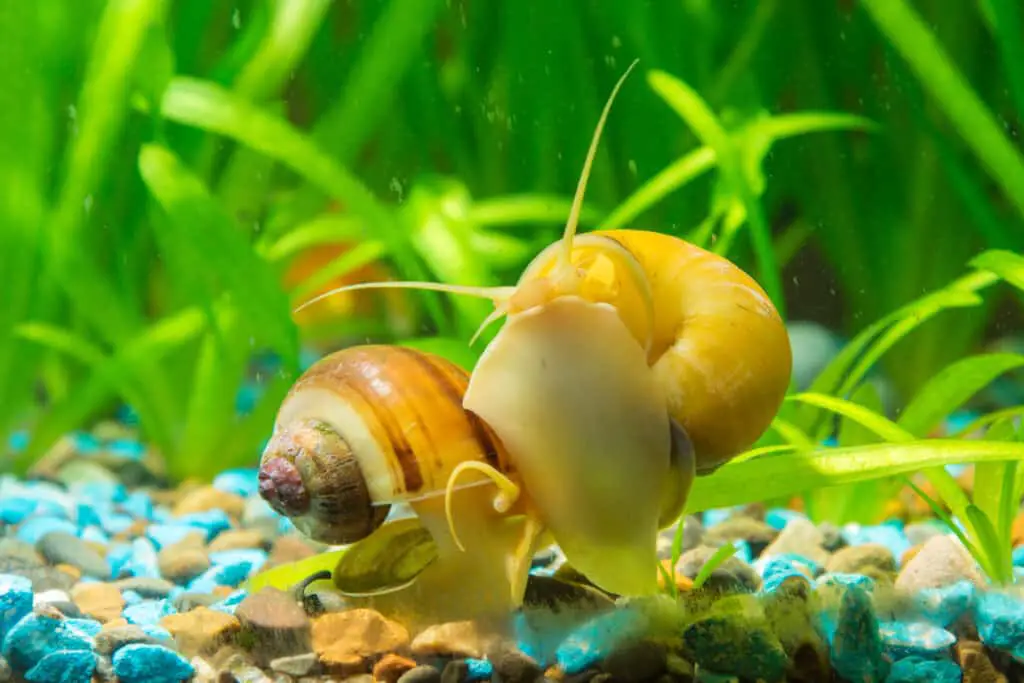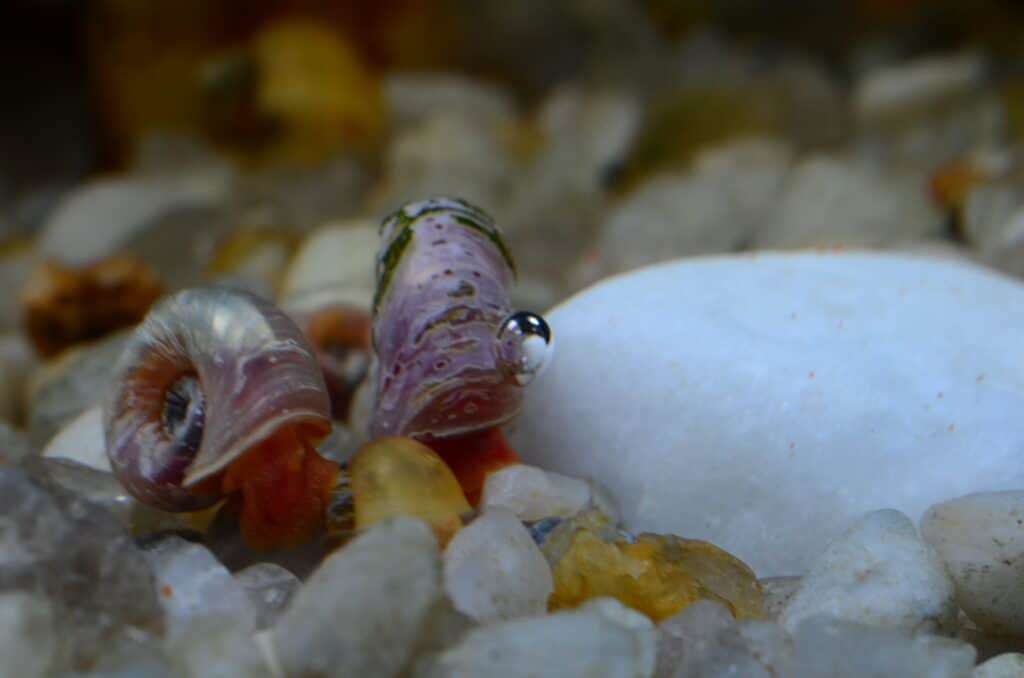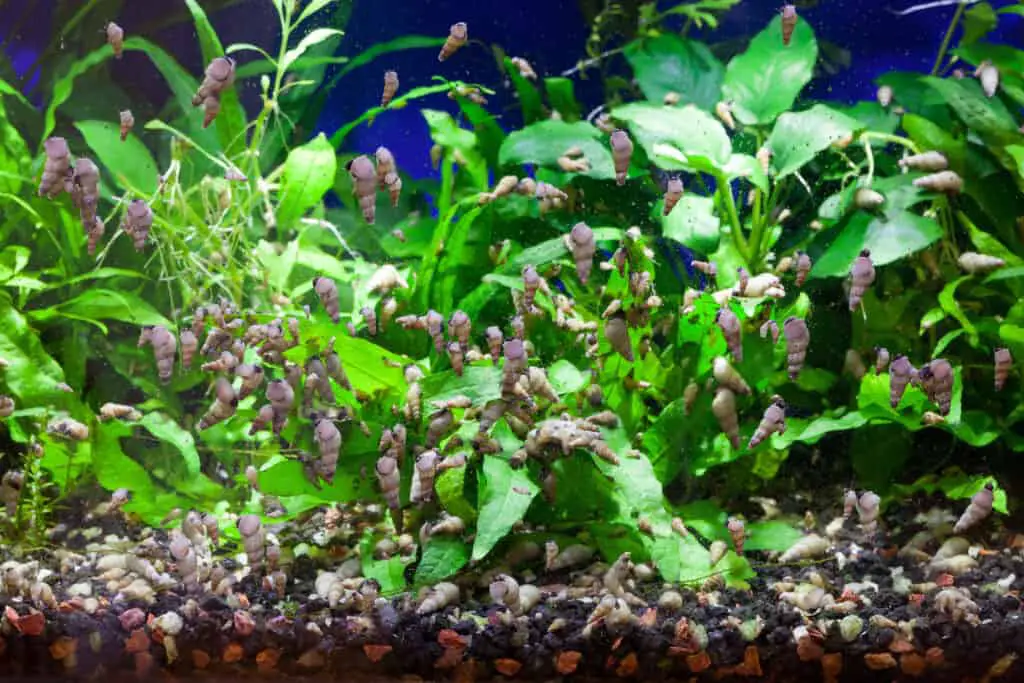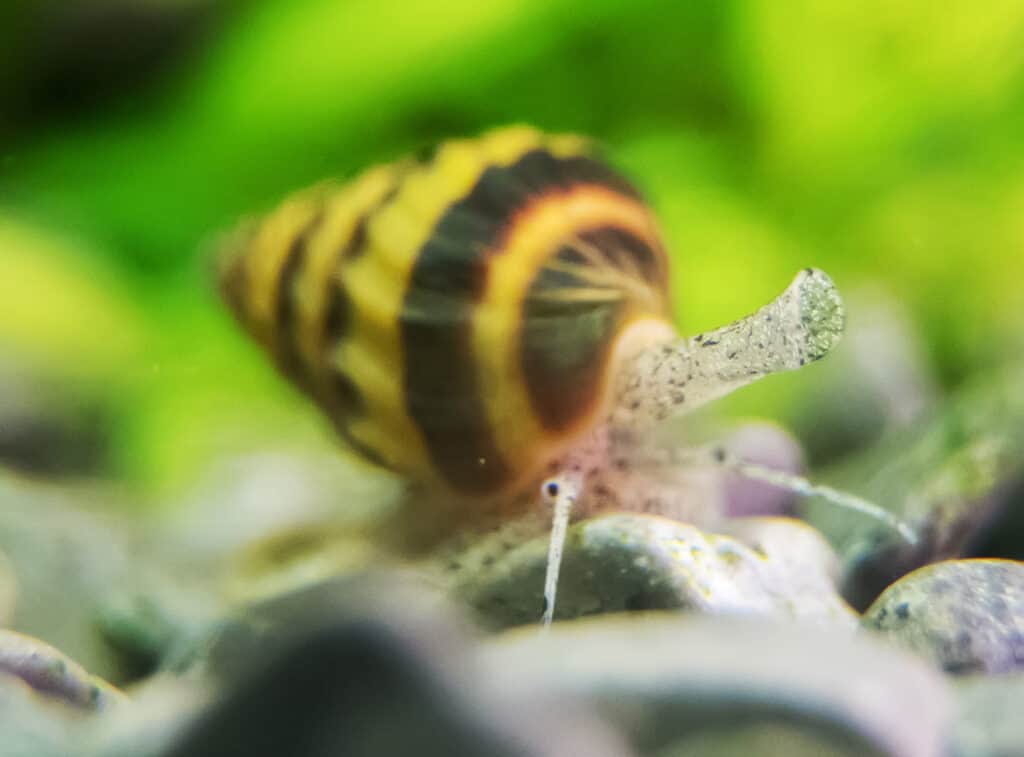
Snails are fascinating and beneficial inhabitants of freshwater fish tanks. They not only add aesthetic appeal with their movements and unique shells, but also serve as valuable members of the tank’s ecosystem by helping with some algae control, detritus consumption, and aerating the substrate. However, not all snail species are compatible with each other in a confined aquatic environment.
Any combination of Mystery Snails, Nerite Snails, and Malaysian Trumpet Snails will make a great pairing. Malaysian Trumpet Snails and Ramshorn Snails also make a great pairing. Snails that have similar diets and differing tank location preferences should make a good pairing.
We will explore compatible snail pairings, along with considerations to be made when selecting snails to place in your tank.
Compatible Snail Pairings
These groupings of snail species would make great combinations in your aquarium.
Nerite Snails and Mystery Snails
Nerite and Mystery snails are two of the most popular species in the fish-keeping hobby.
The various colors and patterns available between the two complement each other nicely.
These two species have very similar dietary preferences making them a great pairing.
Nerite Snails and Malaysian Trumpet Snails
These two are great, as they occupy different sections of the tank.
Most of the time, Nerite snails will stay on hard surfaces, whereas the Malaysian Trumpet snails will bury themselves in the substrate.
This reduces the chances of food competition between the two.
This pairing will work well together in both algae control and detritus management.
Mystery Snails and Malaysian Trumpet Snails
These two species like the Nerite Snail make a great pairing due to their differing behaviors.
Mystery snails will remain mostly on hard surfaces, such as decorations and the sides of the tank, and the Malaysian Trumpet Snails will bury themselves in the substrate.
The big difference between this pairing and the Nerite pairing with Malaysian Trumpet Snails is the size difference.
Mystery Snails will generally grow to between 1 and 2 inches in diameter, while Nerite Snails will stay between ½ to 1 inch.
The combination of Mystery Snails and Malaysian Trumpet Snails provides efficient substrate aeration and surface cleaning.
Ramshorn Snails and Malaysian Trumpet Snails
These two species of snails have similar dietary preferences and will provide your tank algae and detritus control, along with aeration of the substrate.
If looking for a combination of smaller snails, this is the perfect choice.
Both species will generally stay below 1 inch for their entire lifespan.
More About These Species
With the combination of snail species in mind, let’s take a closer look at the individual species of these pairings.
Nerite Snails
Known for shells with striking patterns and their smaller size.
They are great at eating algae which makes them a favorite among aquarium enthusiasts.
Nerite snails come in various colors that range in shade and combination.
These colors include black, dark brown, olive green, tan, golden yellow, and reddish brown.
Mystery Snails
Also referred to as Apple snails are known for their vibrant colors and round shells.
These are one of the larger species found in freshwater tanks growing up to 2 inches in diameter.
They are excellent scavengers, aiding in cleaning up leftover food and detritus.
The colors they come in include black, blue, brown, goldish yellow, ivory white, magenta, olive green, and purple.

Ramshorn Snails
Their name comes from their snail shape that has a distinct coil, resembling the horn of a ram.
These snails can be prolific breeders and are very efficient in managing detritus.
Shell shape and colors can vary with this species, with colors including brownish red, blue, pink, orange, and black.
Malaysian Trumpet Snails
These snails’ shell shape differs from the other snails above, as the Malaysian Trumpet snail’s shell is an elongated, spiral shell, generally coming in a brownish color.
They spend most of their time as burrowers, living beneath the tank’s substrate.
The benefit of this behavior is it can greatly improve the aeration of the aquarium substrate.
These snails are peaceful and unobtrusive but can become numerous if overfed.
Compatibility Considerations
Breeding and Colorations
If you have a desire to breed your snails, consider not only the type of snail but also the colorations.
If you want to keep shell and or snail coloration, then the best way to achieve this is to only have snails with the same colorations.
If colors are combined, over time the offspring will stop having the same colors as the parents.
You may also want to consider only having one species of snail, though some species are compatible with each other, when breeding, the most optimal environments will allow for the best results.
These optimal parameters will vary based on the specific species.
So though two species can live in the same setups, it doesn’t necessarily mean it is the most optimal setup for both.
Habitat and Behavior
When looking to combine different snail species, be sure to understand the habitat and general behavior of the species being considered.
Ones with similar habitat requirements allow all of those species to thrive together, rather than having to thrive and the others not with their requirements not matching.
Also, consider their behaviors, and perfect tank locations.
A pairing that are generally peaceful, and that prefer different areas normally does best, as they are not competing for the same spaces.
This becomes even more important when breeding and population growth occur.
Compatibility Warnings
When checking for compatibility of different species of snails to choose for your tank, there are several areas that you should consider to make to best possible decision.

Overpopulation
Most snail species are prolific breeders that can quickly explode in population growth.
Take this into account as larger species like Mystery Snails and Nerite Snails may begin to compete for space.
Even smaller species, if allowed to expand their numbers, can rapidly cause space issues depending on the size of the tank.
Food Competition
Going with overpopulation is a concern of food competition.
Rapid population growth for snails can cause issues with both food and other necessary resources such as calcium.
Remember that in most cases snails will need to be fed deliberately, and not expect them to rely on scavenged food.
This also goes for instances where the desired reason for the snails is for algae control.
As the populations grow, algae itself will not be able to sustain all of the snails.

Predation
One species not mentioned in the compatible combinations, but could be considered is the Assassin snail.
A word of caution if considering this type of snail, because they prey on other snails, hence their name.
They can be used as a natural population control measure for other snail species, and will generally not harm larger species like the mystery snail, and Nerite snails.
Malaysian Trumpet Snails and Ramshorn Snails on the other hand would have the possibility of becoming prey.
If considering Assassin Snails be sure to understand the risks associated with them to other snail species.
Final Thoughts
Freshwater snails can be an incredible addition to a fish tank, contributing to its overall well-being and aesthetics.
Understanding the various facets of the different species, as well as what makes a great pairing, will allow one to create a harmonious community of snails in your tank.
Remember to take these factors into account when deciding what snails to place in your aquarium.
